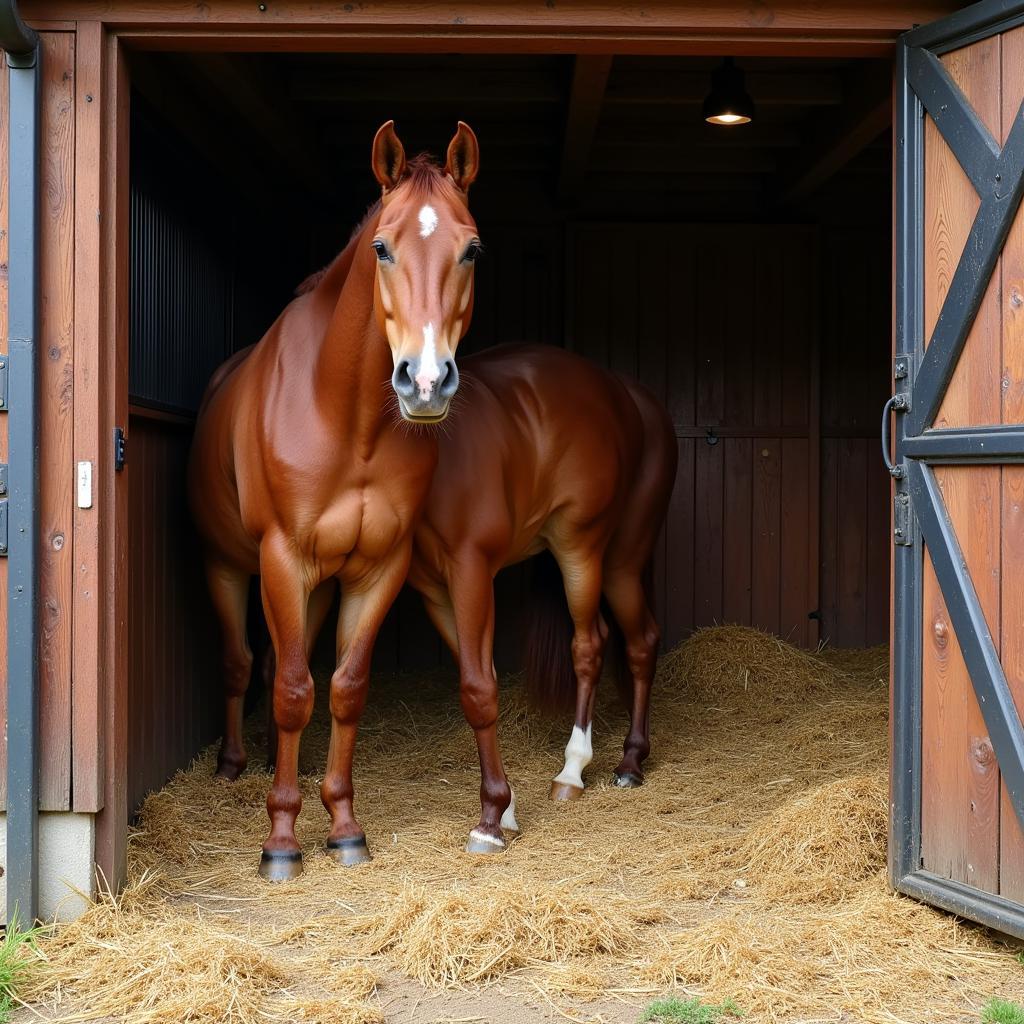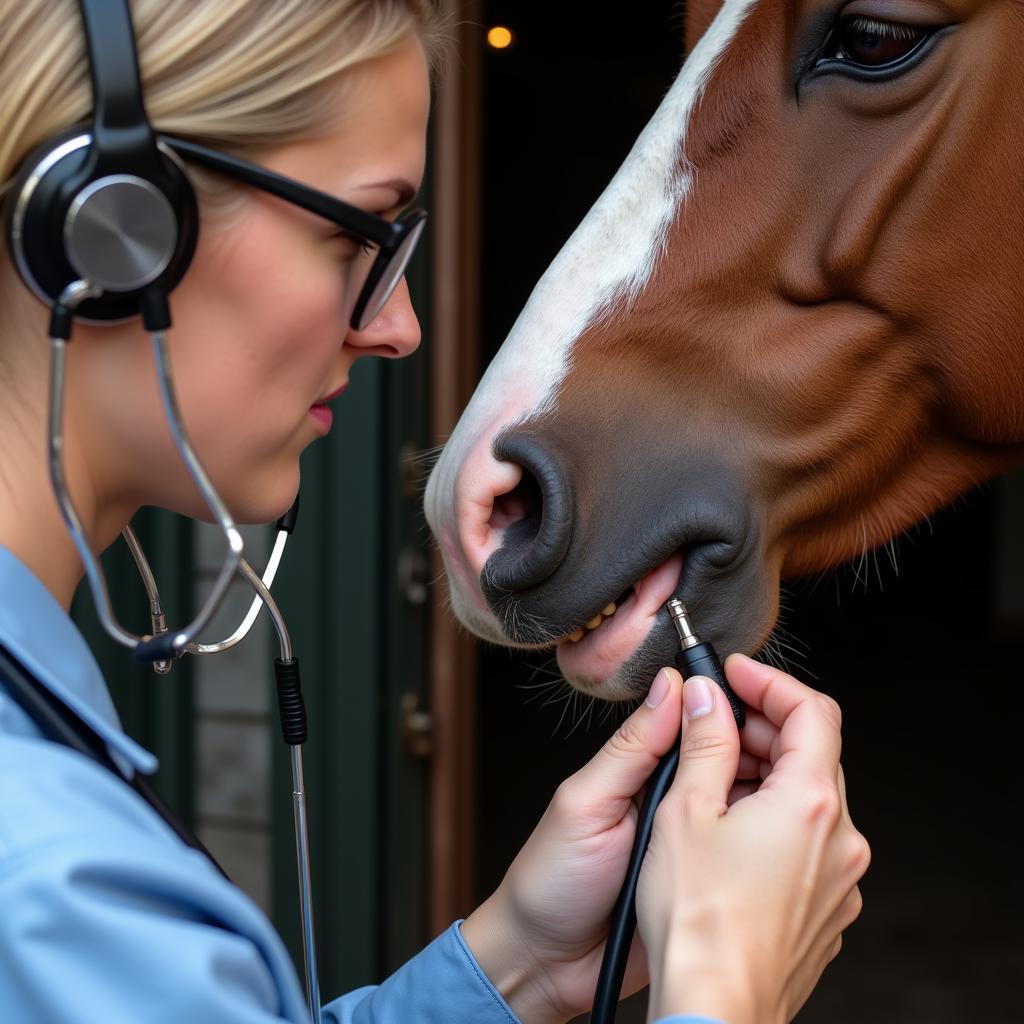Horses primarily eat hay, not straw. While they might nibble on straw occasionally, it lacks the nutritional value of hay and serves primarily as bedding. Understanding the difference between these two common forage materials is crucial for ensuring your horse’s health and well-being.
It’s easy to confuse straw and hay, especially if you’re new to horse ownership. They look similar, but their nutritional profiles are vastly different. Hay is specifically grown as horse feed and is harvested while the plants are still green and nutrient-rich. Straw, on the other hand, is the dry stalk of grain plants after the grain has been harvested. It’s much lower in nutrients and primarily used for bedding. Thinking about giving your horse banana horse treats? Check out our guide on fruits horses can eat!
Hay: The Cornerstone of a Horse’s Diet
Hay provides the essential fiber horses need for healthy digestion. This fiber helps keep their digestive system moving smoothly and prevents colic, a potentially life-threatening condition. Different types of hay, such as Timothy, Orchard grass, and Alfalfa, offer varying levels of protein and other nutrients, allowing you to tailor your horse’s diet to their specific needs. For example, a growing horse or a lactating mare might need the higher protein content of Alfalfa, while a less active horse might do well on Timothy hay.
Straw: Bedding, Not Food
While horses may nibble on straw, it offers minimal nutritional value. It’s primarily used as bedding due to its absorbent properties and ability to create a comfortable stall for your horse. Straw also helps keep the stable clean and dry, reducing the risk of infections and other health issues. If you’re considering straw bedding, you’ll find helpful information in our article on horse straw bedding.
 Horse in Stall with Straw Bedding
Horse in Stall with Straw Bedding
Can Horses Eat Straw at All?
While not ideal, horses can eat small amounts of straw. However, it shouldn’t be a significant part of their diet. Think of it like junk food for humans – a little bit won’t hurt, but too much can lead to digestive upset and nutritional deficiencies. Want to know more about what horses can nibble on? Read more on will horses eat straw.
What Happens if a Horse Eats Too Much Straw?
Consuming excessive amounts of straw can lead to several problems, including impaction colic, a serious and potentially fatal condition. The low nutritional value of straw also means that horses won’t get the essential vitamins and minerals they need, potentially leading to other health issues.
 Veterinarian Examining a Horse
Veterinarian Examining a Horse
“Providing your horse with quality hay is the cornerstone of good equine care,” says Dr. Emily Carter, DVM, an equine veterinarian with over 20 years of experience. “Straw simply doesn’t offer the nutrients they need to thrive.” Dr. Carter further emphasizes, “While a little nibbling on straw might not be harmful, it’s crucial to ensure their primary food source is nutrient-rich hay.”
Why Hay is So Important for Horses
Hay is essential for a horse’s digestive health and overall well-being. Its high fiber content promotes healthy gut function, while the nutrients it provides support healthy growth, energy levels, and a strong immune system.
“Imagine trying to survive on just potato chips,” adds renowned horse nutritionist Sarah Miller. “That’s essentially what it’s like for a horse trying to live on straw. They need the balanced nutrition of hay to stay healthy and strong.” If you’re keeping your horse indoors, providing adequate hay becomes even more important. Learn more about caring for a horse indoors.
In conclusion, hay is the primary food source for horses, providing essential fiber and nutrients. Straw, while sometimes nibbled on, is mainly used for bedding and doesn’t offer the nutritional value necessary for a horse’s health. Ensuring your horse receives a diet primarily based on good quality hay is crucial for their overall well-being.
FAQ
- What type of hay is best for my horse? The best type of hay depends on your horse’s individual needs, such as age, activity level, and health conditions.
- How much hay should I feed my horse? A general guideline is to feed 1.5-2% of the horse’s body weight in hay per day.
- Can I mix different types of hay? Yes, mixing hay can provide a more balanced nutritional profile.
- How do I store hay properly? Hay should be stored in a dry, well-ventilated area to prevent mold and spoilage.
- What are the signs of colic in horses? Signs of colic include pawing, rolling, sweating, and loss of appetite.
- Is it okay for my horse to eat a little straw? A little nibbling is usually not harmful, but straw shouldn’t be a significant part of their diet.
- What are some alternatives to straw bedding? Alternatives include wood shavings, sawdust, and shredded paper.
For further information, you might find our articles on horse straw bedding and will horses eat straw helpful. You can also learn more about treats like banana horse treats and a comprehensive list of fruits horses can eat.
If you need further assistance, please contact us at Phone: 0772127271, Email: [email protected] or visit us at QGM2+WX2, Vị Trung, Vị Thuỷ, Hậu Giang, Việt Nam. We have a 24/7 customer service team.